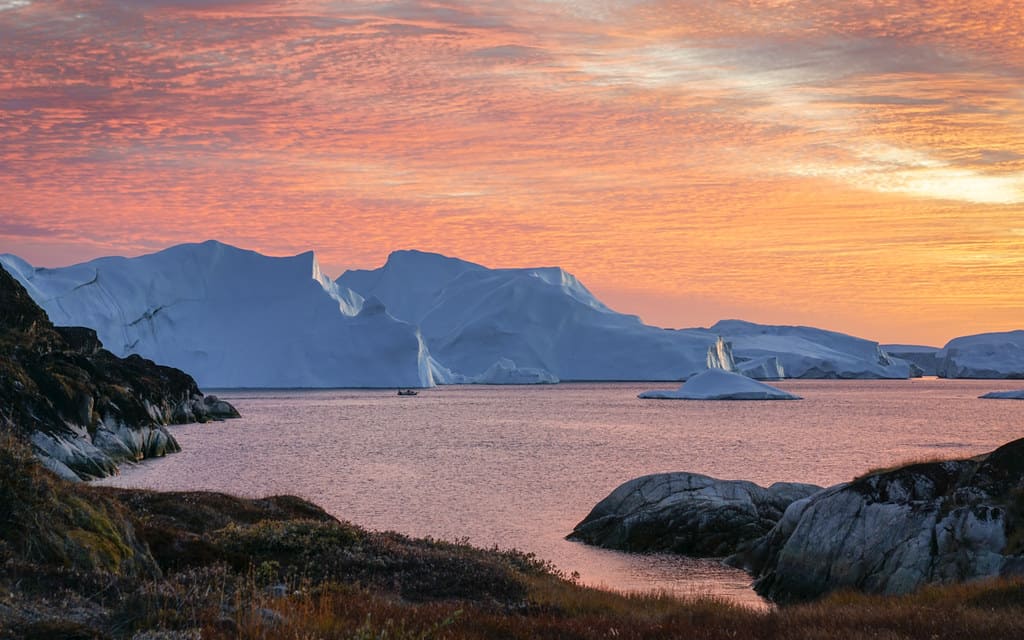Arctic countries are increasingly looking to alternative energy sources to power Arctic development in a sustainable way.
The Arctic is known for its glacial temperatures and pristine ice shelves – in short, for its eternally frozen beauty. However, it’s common knowledge that this environmental magnificence is changing rapidly as Arctic temperatures are rising at an ever-faster pace, to the extent that, according to the Russian meteorological service, Arctic ice cover is now five to seven times thinner compared to the 1980s, contributing to the Arctic Ocean being increasingly ice-free during the summer.
Temperatures in the Arctic are currently rising three times faster than the global average, resulting in a more accessible Arctic – one that is not only expected to surrender its natural resources, but that will inevitably be subject to greater socio-economic development as well. While the push for development in lockstep with rising economic opportunities is regarded all but inevitable, the looming question is how this can be done sustainably.
Indeed, all Arctic nations, which include Russia, the United States, Canada, Norway, Finland, Iceland, Sweden and Denmark, are thus facing an intricate dilemma: having to square the circle between making use of a changing Arctic and doing so in a way that avoids destroying one of the last nearly untouched natural environments on the planet.
Russia, more so than other countries, is expected to make long-term investments in its Arctic territory with a view to develop the Northern Sea Route (NSR), which would not only diversify worldwide logistics routes but also cut shipping times between Europe and Asia. During Russia’s “Arctic Day” in July, nuclear energy company Rosatom committed to building sustainable shipping infrastructure along the NSR as part of long-term investments designed to promote environmentally sensitive regions to commercial shipping.
While these commitments highlight the pressing need for sustainability, the NSR-project represents what is the core of the dilemma faced by Russia and other Arctic countries: the fact that this development – characterized by significant investments into the expansion of extractive industries and, importantly, a growing modern population well-versed in modern technology – requires lots of energy and the construction of relevant infrastructure. But burning more fossil fuels to achieve these changes is not a desirable option, and neither should non-renewable energy sources be used to extract more oil and gas, feeding only a vicious circle that is already spinning out of control.
For this reason, the Arctic countries are increasingly looking to alternative energy sources to power these transformations. Besides renewables, countries like Russia, the United States and Canada are exploring the possibility of using nuclear energy in the form of small modular reactors (SMRs) as a sustainable long-term energy source in the Artic. According to Rauli Partanen, a Finnish expert and analyst of climate change and energy systems, this is an ideal solution: “Nuclear power in general is and can be designed to work well in almost any environment, so in that sense it is an ideal technology also for harsh conditions”, Partanen tells Sustainability Times.
SMRs in particular offer an excellent alternative energy source for local communities, because their application goes beyond simple energy production. “New types of advanced and small reactors now under development are often designed with other uses than merely electricity production in mind”, Partanen explains. As a result, they can also be used for industrial activities that would otherwise require the use of fossil fuels.
“Smaller size and higher temperatures make them good for producing energy services such as industrial steam, high temperatures for more efficient electrolysis for hydrogen and P2X production and combined heat and power for electricity and district heating, for which there is a lot of demand in the Arctic region.”
Importantly, SMRs can also answer another development challenge, namely that of being able to build infrastructure in the harsh Arctic climate. In fact, the current lack of infrastructure and the difficulties in developing it is considered one of the biggest hurdles to energy investments. In recent years, this challenge has been compounded by thawing permafrost which is making the ground too unstable for heavy structures and large-scale power grids. However, floating SMRs, such Russia’s Akademik Lomonosov, the world’s first fully operational ship-based SMR, provide a viable solution to such issues.
“One option for coastal locations is to have floating offshore or near-shore nuclear power plants, such as the Akademic Lomonosov that Russia built a couple years ago”, argues Partanen. “The Akademik Lomonosov offers a great proof of concept of the idea of a floating power plant, and in the future, this concept can be further honed, and costs cut by designing the vessel and reactors for this use right from the start. And with lower costs, this market expands to an enormous one, as most large cities are on the coast and have a rapidly growing need for many energy products, from electricity to district heating to desalinated water and even synthetic fuels.”
Due to their lightweight and small size compared to conventional power plants, nuclear and otherwise, SMRs can be placed at the center of off-grid communities, making long-distance transportation infrastructure, including transmission lines or pipelines, largely unnecessary in favour of localized micro-grids – an idea that many of the new nuclear developers had in mind from the start.
Next to the Akademik Lomonosov design, Oklo’s concept from the US is another case in point. “Oklo’s microreactor design was conceived specifically for isolated grids around mines and smaller towns and villages. The advantage here is that although they will likely cost more than mainstream electricity production, they are competing with imported diesel and generators which are very expensive. Similar arguments can be made for islands that are not connected to mainland-grids and often rely on diesel generators and expensive, imported fuel”, Partanen tells Sustainability Times.
The fact that new nuclear solutions can easily replace fossil fuels is an important one, especially in light of criticism that SMRs cannot compete in terms of costs against said fossil fuels and renewables. But according to Partanen, such criticism is missing the greater picture: “In the short term, SMR’s don’t need to compete with fossil fuels in general, but the more expensive ones like imported diesel. Renewables like wind and solar can’t offer local communities reliable energy at low cost either, especially as there is no cheap import option available that countries like Denmark and Germany currently rely on to keep their grid reliable.”
What this means in the grand scheme of things is that a low-carbon, sustainable development of the Arctic region is certainly possible, and among experts there is a growing consensus that no path will lead past the deployment of small modular reactors. With global warming affecting the Arctic at an accelerating rate, policymakers must ensure that the human impact on the Arctic environment will be mitigated as much as possible going forward.
Image: Lisa Ouellette/Flickr
This story first appeared on Sustainability Times
© 2021 Sustainability Times.
This article is licensed under a Creative Commons Attribution-ShareAlike 4.0 SA International License.












